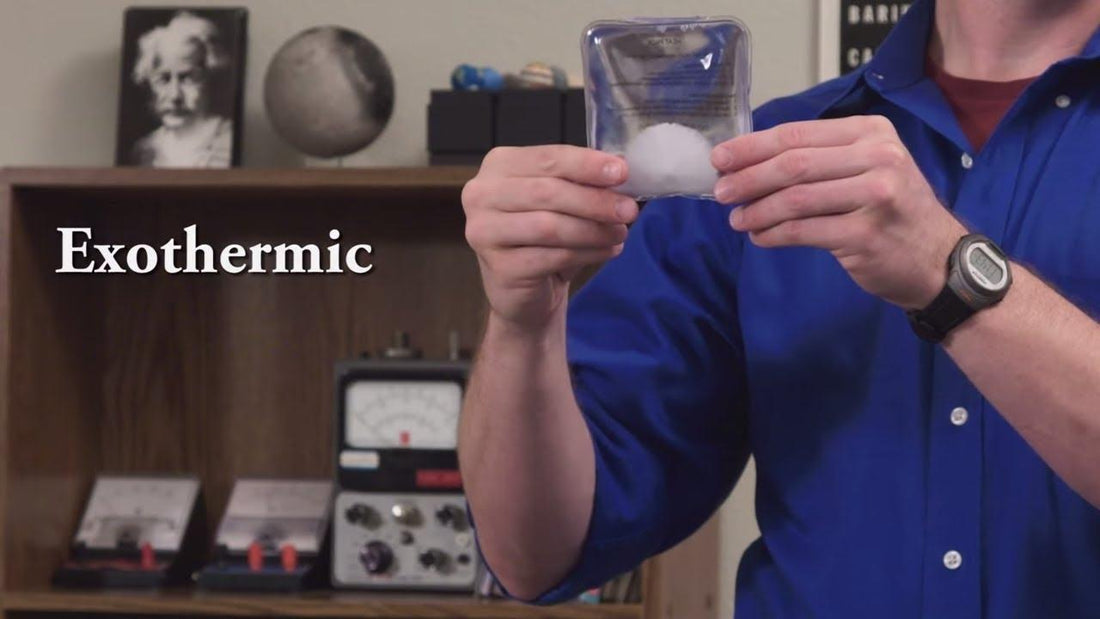Featured Products
Calories From a Heat Pack
This article was written with the intention to focus on middle school science experiments, however, I would not be surprised if high school teachers of physics and chemistry also benefit from it. How many calories of heat are in a hand warmer or "heat pack?"
The heat pack is a convenient way to warm up your hands, but it also can provide a good lesson in physical science. It works by giving off heat in an exothermic physical change. The process is called "Fusion" which is whenever a liquid becomes a solid. In this case, "crystallization" is the specific form of fusion because crystals are formed. In order to melt these crystals, like melting ice, heat would have to be introduced and absorbed (endothermic). However, in this case, in order to form crystals, the reverse happens, heat is released (exothermic). Similarly, water has to have heat removed from it to form ice. Freezing is an exothermic process. But how much heat does it give off?
The "Burn a Peanut Lab" is a well-known approach to measuring calories. The peanut is shelled, skinned, and skewered on a paperclip. It is then burned under a measured mass of water, for example, 200g. A thin metal container, such as a soda can, works fairly well. The temperature is measured both before and after and from these data you can determine the calorie content.
Figure: The heat pack will release thousands of calories as it turns from liquid to crystal. This is the exothermic process known as fusion.
Calories = (Mass) x (∆T)
Here, the mass is in grams, and the ∆T, or change in temperature, is Celsius. The surprise is that there are usually thousands of calories in the peanut, which makes no sense. The lesson is that there are two types of calories: heat calories and food calories. Food calories are 1000 heat calories, also known as a kilocalorie. So, your 2000 calorie diet is really a 2,000,000 calorie diet!
A safer experiment, or a follow-up experiment, is to measure the calories in a heat pack. You do not necessarily have to tell the students the instructions. They can try to figure out a process on their own. The way I usually do this experiment is to place one in an insulating container, with about 200g of water, and click the button. The water will begin to warm up. Don't forget that 1g is 1mL for water.
Figure: The equipment you will need to perform the calories in a heat pack experiment.
Clicking the button forms a tiny crystal seed, called a nucleation site. From this seed, the other crystals grow. The crystal seed is necessary because the liquid in the heat pack is chemically pure. In the case of snowflakes, the seed is usually a speck of dust, but this pack contains pure Sodium Acetate which is super-saturated in water. That means that there is so much sodium acetate that cannot stay dissolved in the water and should be solid (like too much sugar at the bottom of a Kool-Aid mix). Sodium acetate is non-toxic and is even added to food as a seasoning. Chemically, it is a vinegar salt. Perhaps you have eaten it on potato chips?
The heat packs are reusable. When you need to reset the next class, simply boil the heat packs and let them cool. They must be completely boiled because any remaining crystal can be a seed and recrystallize the whole pack.
A typical result I get is that the 200g of water here heated up by 10 degrees Celsius. That makes 2000 calories from the heat pack into the water, during this simple experiment.
The whole story is a bit more complicated. The sodium acetate (Na2CO3) is also heating up itself in the process. If the water is set for a bit longer you can be sure that the sodium acetate and water are the same temperature. The combination of the two heats will give you the total heat released by the heat pack. Here is the equation:
Calories to heat up water + Calories to heat up Sodium Acetate = Total heat released
Qwater + Q Na2CO3 = mCw∆T + mCs∆T = Qtotal
Here the C in the equation is the "specific heat." This value is different for each substance. For water, it is 1. For sodium acetate, it is about 2.5 (because sodium acetate is mixed with water, you may wish to check this for yourself).
Figure: A latent heat diagram for 1 gram of water. Notice that the same amount (80 calories) of heat is needed to either melt or freeze water. In the case of sodium acetate, it is 63 calories/gram.
Lastly, there is the concept of "latent heat" which is the amount of heat expected to be released in a phase change such as freezing or required for a phase change, such as melting. In the case of sodium acetate, this should be about 63 calories/gram. However, you must consider that there is likely water mixed into the heat pack, which can complicate things. You will need to measure the mass of the heat pack to verify the Qvalue.
I recommend sticking to the familiar how many calories lab. I hope that you enjoy extending that lab to include this new experiment. It is fun and easy to do. If you want to do further experiments, cutting open the sodium acetate packs can help you. By adding green food dye you can make "kryptonite crystals," and by pouring it vertically, you can solidify it into mountains or other shapes. Be creative and have fun.
Figure: The Matterhorn shape formed when the sodium acetate crystals grow, solidifying as they touch other sodium acetate crystals.


